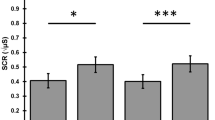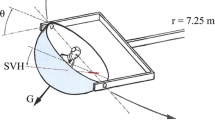Abstract
We have shown that prominent changes in heart rate (HR) and blood pressure (BP) occur in dogs during classical defensive conditioning. These changes are usually analyzed as average HR and BP during control periods versus averages during conditional stimulus (CS) and unconditional stimulus (US) periods. A new method has been developed for evaluation of these functions, viz., analysis across many trials of successive beats beginning at onset of CS and working backward (control period) and forward (CS period). Nine awake dogs were continuously studied: six with HR and intra-arterial BP measurements and three with HR measurements only. A drop in HR occurs 1 to 2 beats after CS onset (often noted as a “dropped” beat on individual trials). In some dogs, on the third to fifth beat HR reaches its maximum during the CS period, thereafter falling slightly, but still above baseline; other dogs show progressively increasing HR throughout the whole CS period. At US onset (foreleg shock) HR usually rises rapidly to a peak greater than that at CS maximum. BP follows HR changes fairly closely, diastolic better than systolic. These results indicate that I) this method can reveal transients previously unsuspected, 2) a prominent initial sudden bradycardia followed by tachycardia commonly occurs in conditioning in dogs, 3) the latent period of prominent HR increase is usually quite short (1.3 to 1.6 secs.), and 4) BP follows HR directly during the early part of the CS.
Similar content being viewed by others
References
Black, A. H., Carlson, N. J., and Solomon, R. L.: Exploratory studies on the conditioning of autonomic responses in curarized dogsPsychol. Monogr.,76 (29, Whole No. 548), 1962.
Dykman, R. A., and Gantt, W. H.: Relation of experimental tachycardia to amplitude of motor activity and intensity of the motivating stimulus.Amer. J. Physiol.,185:495–498, 1956.
Dykman, R. A., and Gantt, W. H.: Experimental psychogenic hypertension: Blood pressure changes conditioned to painful stimuli (Schizokinesis).Bull. Johns Hopkins. Hops.,107:72–89, 1960.
Freedman, B.: Conditioning of respiration and its psychosomatic implications.J. Nerv. Ment. Dis.,113:1–19, 1951.
Gantt, W. H., and Hoffman, W. C.: Conditioned cardio-respiratory changes accompanying conditioned food reflexesAmer. J. Physiol.,129:360–361, 1940.
Gantt, W. H.:Experimental Basis for Neurotic Behavior. New York, Paul B. Hoeber, 1944.
Gantt, W. H.: Cardiovascular components of the conditional reflex to pain, food and other stimuli.Physiol. Rev.,40:266–291, 1960.
Graham, F. K., and Clifton, R. K.: Heart-rate changes as a component of the orienting reflexPsychol. Bull.,65:305–319, 1966.
Lynch, J. J.: Unpublished work, 1966.
Malmo, R. B.: On central and autonomic nervous system mechanisms in conditioning, learning and performanceCanad. J. Psychol.,17:1–36, 1963.
Newton, J. E. O.: AV-block as a conditional response following faradic shock reinforcement.The Physiologist,6:246, 1963.
Newton, J. E. O., and Gantt, W. H.: Curare reveals central rather than peripheral factor determining cardiac orienting reflexAmer. J. Physiol.,199:978–980, 1960.
Perez-Cruet, J., and Gantt, W. H.: The relationship of heart rate to respiration-exceptions to the law of sinus arrhythmia.Fed. Proc.,20:89, 1961.
Perez-Cruet, J.: Conditioning of extrasystoles in humans with respiratory maneuvers as unconditional stimulus.Science,137:1060–1061, 1962.
Perez-Cruet, J., McIntyre, R. W., and Pliskoff, S. S.: Blood-pressure and heart rate in dogs during hypothalamic self-stimulation.J. Comp. & Physiol. Psychol.,60:373–381, 1965.
Perez-Cruet, J., Newton, J. E. O., and Gantt, W. H.: Sinus arrhythmia during panting.Fed. Proc.,24:278, 1965.
Perez-Cruet, J., and Gaertner, R.: Cardiodynamics of cardiac conditional reflexes.Clin. Research,14:257, 1966.
Perez-Cruet, J., Plumlee, L. A., and Newton, J. E. O.: Chronic basal blood pressures in unanesthetized dogs using the ring-catheter technique.Proceedings of the Symposium on Biomedical Engineering,1:383–386, 1966.
Pinto, T., Newton, J. E. O., and Gantt, W. H.: Comparative speed formation: Cardiovascular and motor conditioningFed. Proc.,16:101, 1957.
Robinson, J., and Gantt, W. H.: The orienting reflex (questioning reaction): Cardiac, respiratory, salivary and motor components.Bull. Johns Hopkins.,80:231–253, 1947.
Smith, R. W.: Simple and discriminative cardiac conditioning in humans with sustained inspiration as respiratory control. Unpublished doctoral dissertation, University of Connecticut, 1963.
Sokolov, E. N.: Neuronal models and the orienting reflex. InThe Central Nervous System and Behavior. Brazier, M. A. (Ed.), New York, Josiah Macy, Jr. Foundation, pp. 187–276, 1960.
Teitelbaum, H. A., and Gantt, W. H.: The effect of nembutal anesthesia on the cardiac response to acetylcholine.Anesthesiology,16:261–269, 1955.
Wood, D. M., and Obrist, P. A.: Effects of controlled and uncontrolled respiration on the conditioned heart rate response in humans.J. Exp. Psychol.,68:221–229, 1964.
Zeaman, D., Deane, G., and Wegner, N.: Amplitude and latency characteristic of the conditioned heart response.J. Psychol.,38:235–250, 1954.
Zeaman, D., and Smith, R. W.: Review of some recent findings in human cardiac conditioning. InClassical Conditioning: A Symposium. Ed. Prokasy, W. F. New York, Appleton-Century-Crofts, pp. 378–418, 1965.
Author information
Authors and Affiliations
Additional information
This research was supported by NIH Grant HE-06945-05 and NASA Grant NsG520.
Rights and permissions
About this article
Cite this article
Newton, J.E.O., Perez-Cruet, J. Successive-beat analysis of cardiovascular orienting and conditional responses. Conditional Reflex 2, 37–55 (1967). https://doi.org/10.1007/BF03034094
Issue Date:
DOI: https://doi.org/10.1007/BF03034094




